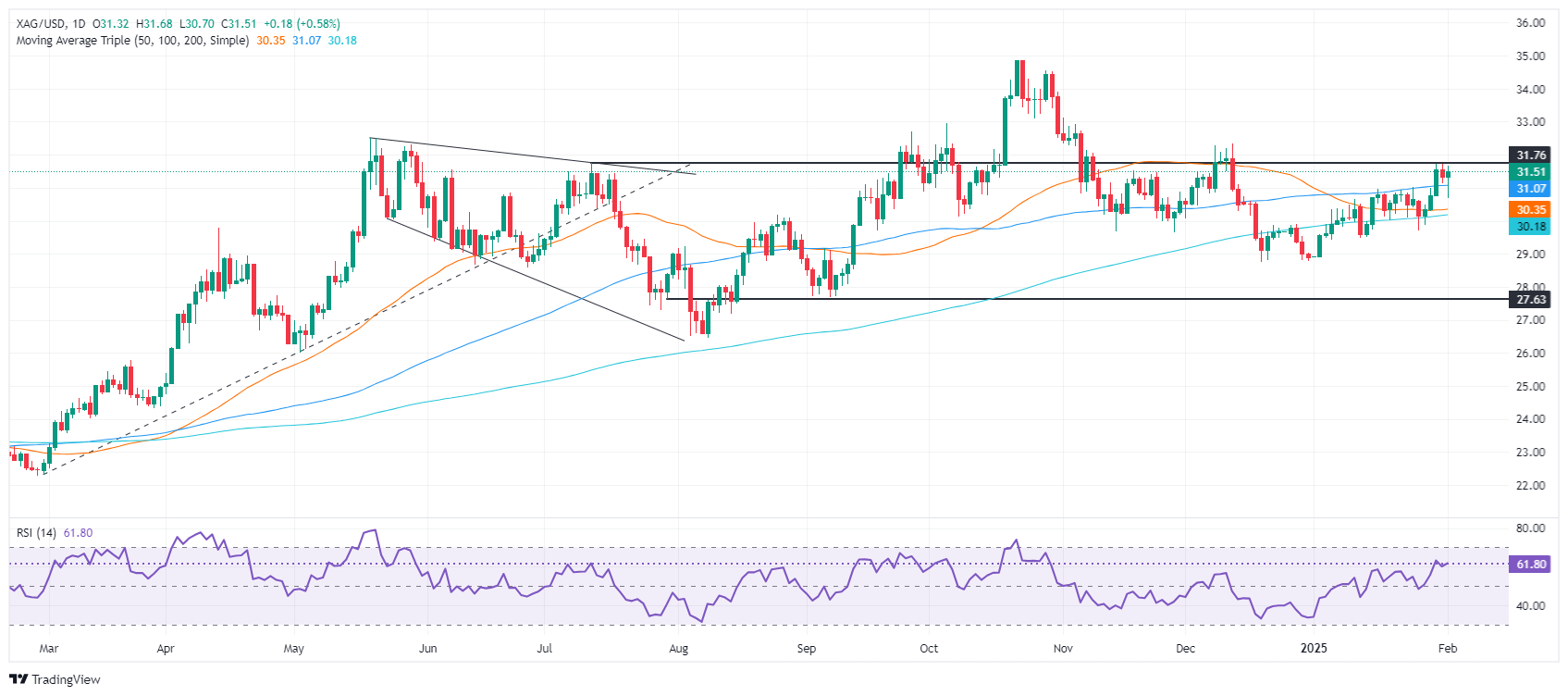Silver Price Forecast: XAG/USD climb amid rising global trade tensions
- Silver rises 0.71%, trading between $30.60 and $31.60, awaiting clear market direction.
- Bullish technical momentum; a break above $32.00 could push gains to $34.00.
- Risk of downside if silver falls below $31.00, potential pullback to $30.32 SMA support.
Silver prices advance late in the North American session on Monday, up 0.71%, as trade tensions between the US, Canada, China, and the Eurozone (EU) rise. The XAG/USD trades at $31.49 at the time of writing.
XAG/USD Price Forecast: Technical outlook
The XAG/USD has consolidated within the $30.60-$31.60 area during the last two days but lacks a clear bias in the medium-to-long term, indicating that neither buyers nor sellers are in charge.
Nevertheless, according to the Relative Strength Index (RSI), momentum indicates that bulls have the upper hand. However, they need to clear key ceiling levels before the grey metal turns bullish from a market structure point of view.
If buyers clear the $32.00 figure, this will shift the bias to upwards, paving the way for testing the December 12 high at $32.32, followed by the October 25 swing low of $33.09. On further strength, the next resistance will be the $34.00 mark.
However, if bears push prices below $31.00 daily, the next support would be the 50-day Simple Moving Average (SMA) at $30.32, followed by the 200-day SMA at $30.16.
XAG/USD Price Chart – Daily

Silver FAQs
Silver is a precious metal highly traded among investors. It has been historically used as a store of value and a medium of exchange. Although less popular than Gold, traders may turn to Silver to diversify their investment portfolio, for its intrinsic value or as a potential hedge during high-inflation periods. Investors can buy physical Silver, in coins or in bars, or trade it through vehicles such as Exchange Traded Funds, which track its price on international markets.
Silver prices can move due to a wide range of factors. Geopolitical instability or fears of a deep recession can make Silver price escalate due to its safe-haven status, although to a lesser extent than Gold's. As a yieldless asset, Silver tends to rise with lower interest rates. Its moves also depend on how the US Dollar (USD) behaves as the asset is priced in dollars (XAG/USD). A strong Dollar tends to keep the price of Silver at bay, whereas a weaker Dollar is likely to propel prices up. Other factors such as investment demand, mining supply – Silver is much more abundant than Gold – and recycling rates can also affect prices.
Silver is widely used in industry, particularly in sectors such as electronics or solar energy, as it has one of the highest electric conductivity of all metals – more than Copper and Gold. A surge in demand can increase prices, while a decline tends to lower them. Dynamics in the US, Chinese and Indian economies can also contribute to price swings: for the US and particularly China, their big industrial sectors use Silver in various processes; in India, consumers’ demand for the precious metal for jewellery also plays a key role in setting prices.
Silver prices tend to follow Gold's moves. When Gold prices rise, Silver typically follows suit, as their status as safe-haven assets is similar. The Gold/Silver ratio, which shows the number of ounces of Silver needed to equal the value of one ounce of Gold, may help to determine the relative valuation between both metals. Some investors may consider a high ratio as an indicator that Silver is undervalued, or Gold is overvalued. On the contrary, a low ratio might suggest that Gold is undervalued relative to Silver.

